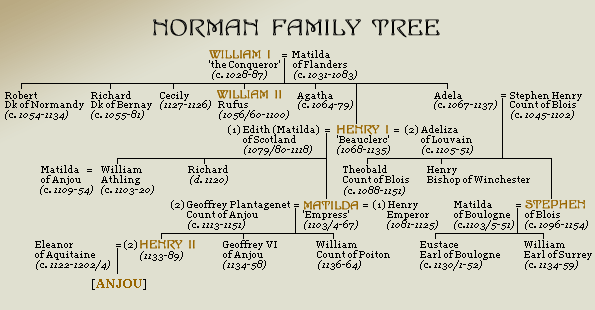
William The Conqueror was the first Norman king of England. His son,William II, became King of England. When William II died without issue, his brother, Henry I, became King of England. When Henry I died, his daughter, Matilda (Empress Maud from her first marriage to the Holy Roman Emperor) should have become Queen of England. Instead, his nephew, Stephen, took the thrown. Stephen's reign was marked by the Anarchy, a civil war with his cousin and rival, the Empress Matilda.(If you have ever seen the "Brother Cadfael" mystery series staring Derek Jacobi, it is set in this period.)
In 1153 the Empress's son from her second marriage to the Count of Anjou, Henry, invaded England and built an alliance of powerful regional barons to support his claim for the throne. The two armies met at Wallingford but neither side's barons were keen to fight another pitched battle. Stephen began to examine a negotiated peace, a process hastened by the sudden death of Eustace, his first son. Stephen and Henry agreed to the Treaty of Winchester later in the year, in which Stephen recognized Henry as his heir in exchange for peace, passing over William, Stephen's second son. Stephen died the following year, and he was succeeded by Matilda's son, Henry II. Henry II is considered to be the first Angevin King of England. (Angevin means the House of Anjou.) Henry II being the Count of Anjou. Henry II expanded the family's holdings into what was later termed the Angevin Empire as shown below.
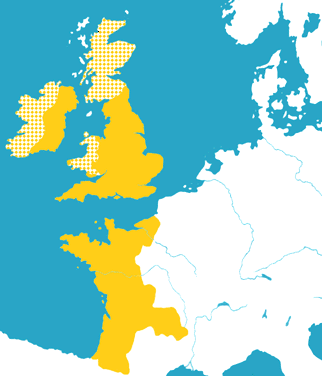
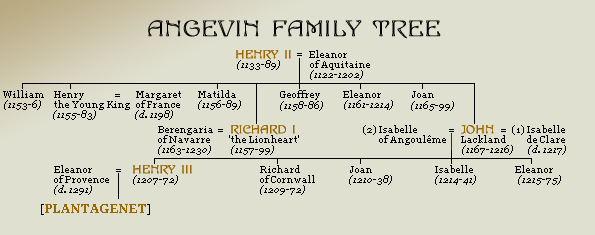
Henry II married Eleanor of Aquitaine (both featured in "Becket" and "The Lion In Winter") was succeeded by his son, Richard I (Richard The Lionheart), who was succeeded by his brother, King John (Magna Carte and Robin Hood). After John lost the Angevins' continental territory (except for Calais), the family became known as the House of Plantagenet. (Plantagenet was a nickname for Henry II's father, whose emblem may have been the common broom - planta genista in medieval Latin.) King John was succeeded by his son, Henry III.

Henry III was succeeded by his son, Edward I, who was succeeded by his son, Edward II, who was succeeded by his son, Edward III, Edward III's son, Edward, the Black Prince predeceased Edward III. (Errol Flynn's last swashbuckler film role in 1955 was playing the Black Prince in "The Warriors" also known as "The Dark Avenger"). The Black Prince's son, Richard II became King of England on the death of Edward III. Richard II was overthrown by his first cousin once removed, Henry IV. Henry IV's father was the Duke of Lancaster, which is why Henry IV founded the House of Lancaster. Richard II was the last Plantagenet King of England.
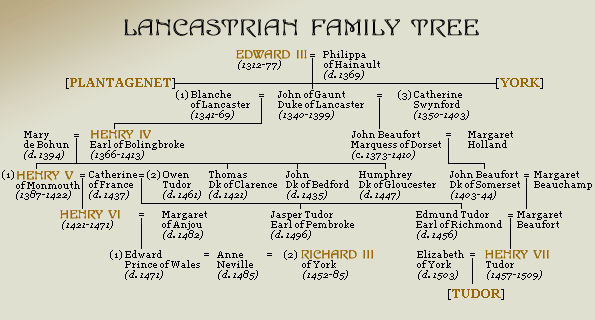
Henry IV was succeeded by his son, Henry V, who was succeeded by his son, Henry VI. Henry VI was overthrown, by his third cousin, Edward IV. Edward IV was the Duke of York, which is why he established the House of York.
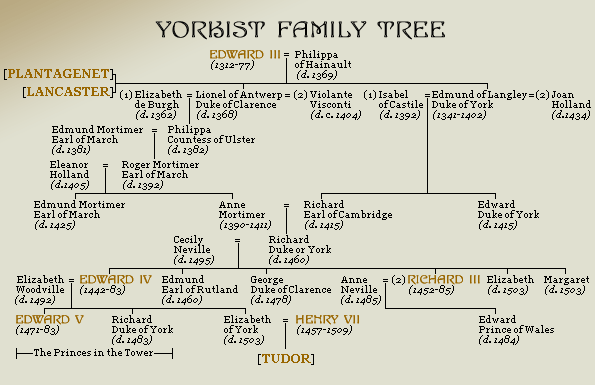
Edward IV, was succeeded briefly, by his son, Edward V. Edward V was deposed by his uncle, Richard III, the brother of Edward IV. Richard III was deposed by Henry Tudor, Henry VII.
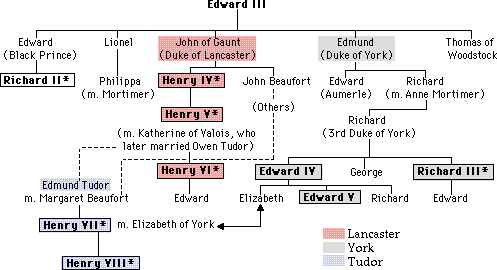
Henry VII had a very weak claim to the throne of England. Henry's paternal grandfather, Owen Tudor, had been a page in the court of Henry V. Owen secretly married the widow of Henry V, Catherine of Valois. One of their sons was Edmund Tudor, father of Henry VII. Edmund was created Earl of Richmond in 1452, and "formally declared legitimate by Parliament". Henry's main claim to the English throne derived from his mother through the House of Beaufort. Henry's mother, Lady Margaret Beaufort, was a great-granddaughter of John of Gaunt, Duke of Lancaster, fourth son of Edward III, and his third wife Katherine Swynford. Katherine was Gaunt's mistress for about 25 years; when they married in 1396, they already had four children, including Henry's great-grandfather John Beaufort. Thus Henry's claim was somewhat tenuous: it was from a woman, and by illegitimate descent. Richard II legitimised Gaunt's children by Katherine Swynford by Letters Patent in 1397. In 1407, Henry IV, who was Gaunt's son by his first wife, issued new Letters Patent confirming the legitimacy of his half-siblings, but also declaring them ineligible for the throne. Henry IV's action was of doubtful legality, as the Beauforts were previously legitimized by an Act of Parliament, but it further weakened Henry's claim. Nonetheless, by 1483 Henry was the senior male Lancastrian claimant remaining, after the death of Henry VI.
Henry VII married Elizabeth of York, the Daughter of Edward IV, and together they founded the House of Tudor, which ended the War of the Roses. The symbol of the House of Lancaster was the Red Rose. The symbol of the House of York was the White Rose, and the symbol of the House of Tudor was the Tudor Rose, which was both red and white:

No comments:
Post a Comment